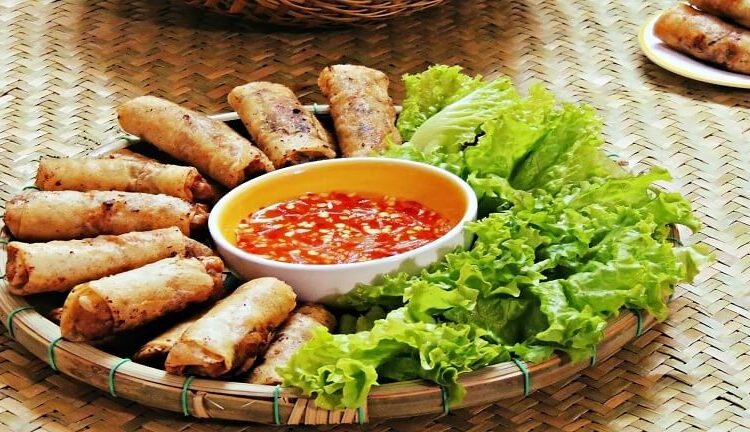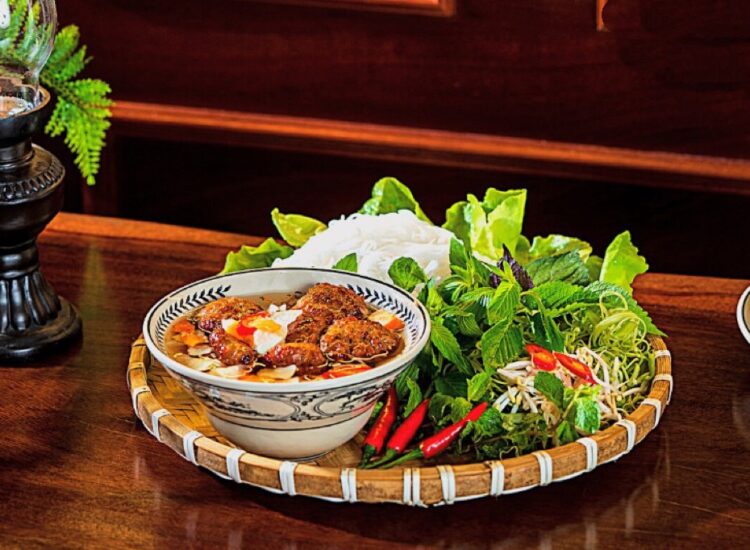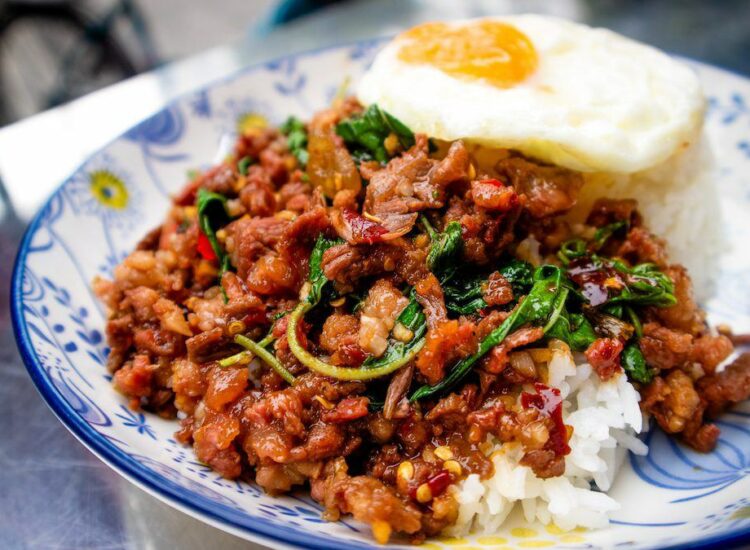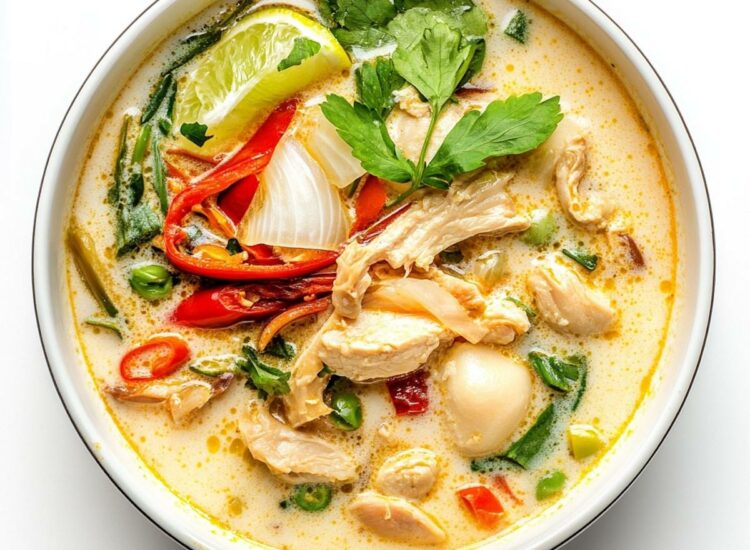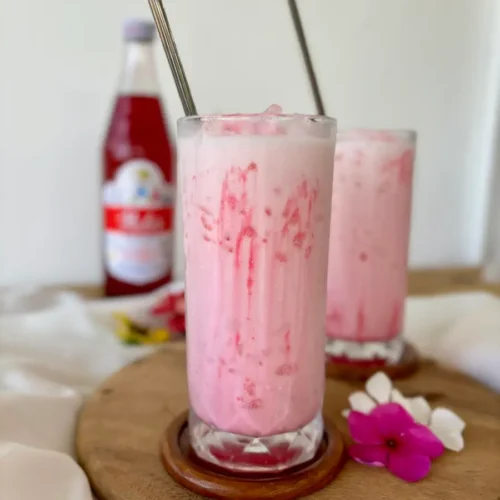Penang Curry, or Kari Kapitan as it is locally known, is more than just a dish; it’s a vibrant tapestry of flavors woven from the rich culinary heritage of Penang, Malaysia. This aromatic and creamy curry stands as a testament to the island’s unique blend of cultures, a harmonious marriage of Malay, Chinese, Indian, and Peranakan influences that have shaped its gastronomic identity for centuries. Penang Curry is not fiery hot like some of its Southeast Asian counterparts, but rather a symphony of warm spices, fragrant herbs, and the comforting richness of coconut milk, all balanced with a subtle tang that elevates it beyond the ordinary. It’s a dish that whispers stories of trade routes, cultural exchanges, and generations of cooks perfecting their family recipes, making it a true embodiment of Penang’s culinary soul.

A Historical Tapestry: The Origins of Penang Curry
To understand Penang Curry, one must first delve into the historical context of Penang itself. Situated strategically at the crossroads of major maritime trade routes, Penang Island, off the northwest coast of Malaysia, became a melting pot of cultures from the moment it was established as a British trading post in 1786. This influx of traders, settlers, and immigrants from various parts of Asia and beyond – including India, China, Thailand, and the Middle East – profoundly influenced the island’s cuisine.
The term “Kapitan” in Kari Kapitan offers a fascinating clue to the dish’s origins. “Kapitan” was a title given to community leaders, particularly within the Chinese and Malay communities during the colonial era. It suggests that this curry might have been a dish favored by or perhaps even created for these influential figures. Some culinary historians believe that Kari Kapitan evolved from a simpler Malay or Indian curry base, refined and enriched over time with the addition of ingredients and techniques from other cultures present in Penang.
The Chinese influence is evident in the use of ingredients like candlenuts, which contribute to the curry’s creamy texture and subtle nutty flavor. The Indian influence is undeniable in the complex spice blend, reminiscent of South Indian curries, yet adapted to local tastes. The use of lemongrass, galangal, and chilies points to Malay culinary traditions, while the creamy coconut milk is a common thread throughout Southeast Asian cuisines.
Peranakan cuisine, the unique culinary tradition of Straits-born Chinese communities, also played a significant role in shaping Penang Curry. Peranakan cooking is characterized by its intricate spice blends, use of local ingredients, and a harmonious balance of sweet, sour, and spicy flavors. Kari Kapitan shares many of these characteristics, suggesting a strong Peranakan influence in its development.
Over generations, Penang Curry has evolved from a potentially humble dish into a celebrated culinary icon of the island. Family recipes have been passed down, each with its own nuances and secret ingredients, contributing to the rich diversity of Penang Curry found today. It’s a dish that reflects the island’s history, its people, and their ability to create something uniquely delicious from a confluence of cultures.
The Symphony of Spices: Unpacking the Flavor Profile
The magic of Penang Curry lies in its intricate blend of spices and aromatics, carefully balanced to create a flavor profile that is both complex and comforting. Unlike some fiery curries, Penang Curry is characterized by its aromatic warmth rather than overwhelming heat. It’s a curry that invites you to savor each layer of flavor, from the initial spice notes to the creamy coconut finish.
The spice paste, or rempah, is the heart and soul of Penang Curry. While specific recipes vary, certain key spices are essential to achieving its distinctive flavor. These typically include:
- Dried Chilies: Provide a gentle warmth and a subtle fruity note, contributing to the curry’s reddish hue.
- Turmeric: Imparts a vibrant yellow color and an earthy, slightly bitter flavor, along with its well-known health benefits.
- Cumin: Adds a warm, earthy, and slightly bitter note, contributing to the curry’s depth.
- Coriander Seeds: Lend a citrusy, slightly sweet, and nutty aroma, balancing the other spices.
- Fennel Seeds: Contribute a licorice-like aroma and a subtle sweetness, adding complexity to the spice blend.
- Candlenuts (Buah Keras): These nuts are crucial for the curry’s creamy texture and subtle nutty flavor. They act as a natural thickener and emulsifier.
- White Peppercorns: Offer a pungent heat and a bright, clean flavor, enhancing the overall spice profile.
Beyond the dry spices, a medley of fresh aromatics further elevates Penang Curry:
Related articles 01:
1. https://chobangkaewthai.com/thai-beer-the-drink-that-beats-summer-fatigue
2. https://chobangkaewthai.com/nom-yen-a-refreshing-drink-not-to-be-missed
3. https://chobangkaewthai.com/thai-whisky-the-essence-of-sugarcane
4. https://chobangkaewthai.com/a-journey-through-time-unraveling-the-history-of-massaman-curry
5. https://chobangkaewthai.com/cha-yen-delicious-drinks-from-tea-leaves
- Lemongrass: Provides a bright, citrusy, and slightly floral aroma, essential for the curry’s fragrance.
- Galangal (Lengkuas): Offers a pungent, peppery, and slightly citrusy flavor, adding depth and complexity.
- Ginger: Imparts a warm, spicy, and slightly sweet flavor, contributing to the overall aromatic warmth.
- Shallots: Provide a milder, sweeter onion flavor compared to regular onions, forming the aromatic base of the curry.
- Garlic: Adds a pungent and savory note, essential for building flavor depth.
- Belacan (Shrimp Paste): A fermented shrimp paste that provides a deeply savory, umami-rich flavor that is fundamental to many Southeast Asian curries.
The interplay of these spices and aromatics, when expertly blended and cooked, creates the signature flavor of Penang Curry. The initial taste is often a warm, fragrant spice blend, followed by the creamy richness of coconut milk, and a subtle tang that brightens the overall profile. The heat is present but not overpowering, allowing the other flavors to shine through.
Variations and Adaptations: A Curry for Every Palate

While the core elements of Penang Curry remain consistent, the dish is remarkably adaptable, allowing for variations based on personal preferences and regional influences. This flexibility is part of its enduring appeal, making it a dish that can be enjoyed by a wide range of palates.
One of the most common variations lies in the choice of protein. While chicken is the most traditional and widely enjoyed option, Penang Curry can be equally delicious with other proteins:
- Chicken: The classic choice, chicken absorbs the flavors of the curry beautifully and remains tender during cooking.
- Beef: Beef Penang Curry is richer and more robust, requiring longer cooking times to tenderize the meat.
- Mutton: Mutton adds a distinctive gamey flavor that complements the spices in the curry.
- Prawns/Shrimp: Seafood versions are lighter and quicker to cook, offering a delicate sweetness that pairs well with the curry.
- Fish: Firm white fish fillets can be used, but care must be taken to avoid overcooking as they are more delicate.
- Vegetarian/Vegan: For vegetarian or vegan versions, tofu, tempeh, or a variety of vegetables like potatoes, cauliflower, eggplant, and green beans can be used.
Spice levels can also be adjusted to suit individual preferences. Some recipes may include bird’s eye chilies for a hotter kick, while others might rely solely on dried chilies for a milder warmth. The balance of sweet and sour can also be tweaked. Some cooks add a touch of palm sugar for sweetness, while others might increase the tamarind paste for a more pronounced tang.
Regional variations also exist within Penang and across Malaysia. In some areas, you might find Penang Curry with the addition of potatoes or long beans, while others might emphasize the use of specific local herbs or spices. Peranakan households often have their own closely guarded family recipes, each subtly different yet recognizably Penang Curry.
This adaptability makes Penang Curry a dish that can be constantly rediscovered and enjoyed in new ways. Whether you prefer a milder or spicier version, with chicken or seafood, there’s a Penang Curry variation to suit every taste.
Cultural Significance: Penang Curry as a Culinary Icon
Penang Curry is not just a popular dish in Penang; it’s a culinary icon that represents the island’s unique cultural identity. It’s a dish that is deeply ingrained in the local food scene, found everywhere from humble hawker stalls to upscale restaurants. For Penangites, Kari Kapitan is more than just a meal; it’s a taste of home, a connection to their heritage, and a source of local pride.
Penang is renowned as a food paradise in Malaysia, and Penang Curry is often cited as one of the must-try dishes for visitors. Its distinctive flavor profile, different from other Malaysian curries like Nasi Kandar or Rendang, sets it apart and contributes to Penang’s reputation as a culinary melting pot.
The dish is frequently featured in Penang’s numerous food festivals and culinary events, showcasing its importance in the local gastronomic landscape. It’s also a staple in Penangite households, often cooked for family gatherings, festive occasions, and celebrations. Family recipes for Penang Curry are treasured and passed down through generations, representing a tangible link to culinary heritage.
Beyond Penang, the popularity of Penang Curry has spread throughout Malaysia and internationally, thanks to the diaspora of Penangites and the growing global interest in Malaysian cuisine. It can be found in Malaysian restaurants worldwide, often highlighted as a specialty of Penang cuisine. This global reach has further cemented Penang Curry’s status as a significant dish in Malaysian culinary heritage.
Related articles 02:
1. https://chobangkaewthai.com/oliang-thai-coffee-you-shouldnt-miss
2. https://chobangkaewthai.com/a-journey-through-time-unraveling-the-history-of-massaman-curry
3. https://chobangkaewthai.com/bun-cha-a-culinary-journey-into-vietnams-iconic-grilled-pork-and-noodles
4. https://chobangkaewthai.com/thai-whisky-the-essence-of-sugarcane
5. https://chobangkaewthai.com/kai-yang-the-ultimate-guide-to-thai-grilled-chicken
In essence, Penang Curry embodies the spirit of Penang – a harmonious blend of cultures, a rich history, and a vibrant culinary scene. It’s a dish that tells a story, evokes a sense of place, and offers a delicious taste of Penang’s unique cultural identity.
A Simplified Recipe: Bringing Penang Curry to Your Kitchen
While mastering the intricacies of Penang Curry might take time and practice, a simplified version can be easily prepared at home, allowing you to experience the essence of this flavorful dish. Here’s a basic recipe to get you started:
Ingredients:
- For the Spice Paste (Rempah):
- 5-7 Dried Red Chilies, soaked in hot water until softened
- 5-7 Candlenuts, roughly chopped
- 2-3 Shallots, roughly chopped
- 3-4 Cloves Garlic
- 1-inch piece Galangal (Lengkuas), roughly chopped
- 1-inch piece Ginger, roughly chopped
- 1 stalk Lemongrass, white part only, roughly chopped
- 1 teaspoon Cumin Seeds
- 1 teaspoon Coriander Seeds
- ½ teaspoon Fennel Seeds
- ½ teaspoon Turmeric Powder
- ¼ teaspoon White Peppercorns
- 1 teaspoon Belacan (Shrimp Paste)
- Main Ingredients:
- 500g Chicken pieces (thighs or drumsticks work well)
- 400ml Coconut Milk
- 1 tablespoon Tamarind Paste, mixed with ¼ cup hot water and strained
- 1 tablespoon Cooking Oil
- Salt and Sugar to taste
- Optional: Potatoes, Long Beans, Kaffir Lime Leaves
Instructions:
- Prepare the Spice Paste (Rempah): Combine all spice paste ingredients in a blender or food processor and blend until smooth. Add a little water if needed to help blending.
- Sauté the Spice Paste: Heat oil in a pot or wok over medium heat. Add the spice paste and sauté for 5-7 minutes, or until fragrant and the oil starts to separate. Stir constantly to prevent burning.
- Add Chicken and Coconut Milk: Add chicken pieces to the pot and stir to coat them with the spice paste. Cook for a few minutes until the chicken is lightly browned. Pour in coconut milk and bring to a simmer.
- Simmer and Thicken: Reduce heat to low and simmer for 20-25 minutes, or until chicken is cooked through and tender. If using potatoes or long beans, add them about 15 minutes into the simmering time.
- Add Tamarind Juice and Season: Stir in tamarind juice. Season with salt and sugar to taste. Adjust sweetness and sourness according to your preference. If using kaffir lime leaves, add them in the last 5 minutes of cooking for extra fragrance.
- Serve: Simmer for another 5 minutes, allowing the flavors to meld. Remove from heat and serve hot.
Serving Suggestions and Pairings: Completing the Penang Curry Experience
Penang Curry is typically served with steamed white rice, the perfect neutral canvas to absorb the rich and flavorful gravy. However, it can also be enjoyed with other accompaniments to create a complete and satisfying meal.
- Rice: Steamed white rice is the classic pairing, allowing the curry to be the star of the show.
- Noodles: For a less traditional but equally delicious option, Penang Curry can be served with flat rice noodles (kway teow) or egg noodles.
- Bread: Crusty bread or roti canai (Malaysian flatbread) are excellent for soaking up the flavorful gravy.
- Side Dishes: Complementary side dishes can enhance the meal. Consider:
- Achar (Pickled Vegetables): The tangy and crunchy achar provides a refreshing contrast to the rich curry.
- Cucumber and Tomato Salad: A simple salad with sliced cucumbers and tomatoes offers a cooling element.
- Papadums: Crispy Indian lentil crackers add a textural contrast.
- Vegetable Stir-fry: A simple vegetable stir-fry can add balance to the meal.
To fully appreciate Penang Curry, it’s best enjoyed hot, allowing the aromatic spices and creamy coconut milk to tantalize your senses. It’s a dish that is comforting and satisfying, perfect for a family meal or a special occasion.
Conclusion: A Culinary Journey to Penang
Penang Curry is more than just a recipe; it’s a culinary journey to the heart of Penang, Malaysia. It’s a dish that encapsulates the island’s rich history, its diverse cultural influences, and its vibrant food scene. From the intricate spice blend to the creamy coconut milk, every element of Penang Curry contributes to its unique and unforgettable flavor profile. Whether you’re a seasoned curry enthusiast or new to Southeast Asian cuisine, Penang Curry offers a delightful and aromatic experience that is sure to captivate your palate. By recreating this dish in your own kitchen, you’re not just cooking a meal; you’re immersing yourself in the culinary soul of Penang, savoring a taste of its history and culture with every spoonful. Penang Curry is a testament to the power of food to tell stories, connect cultures, and bring people together through the shared joy of delicious flavors.

